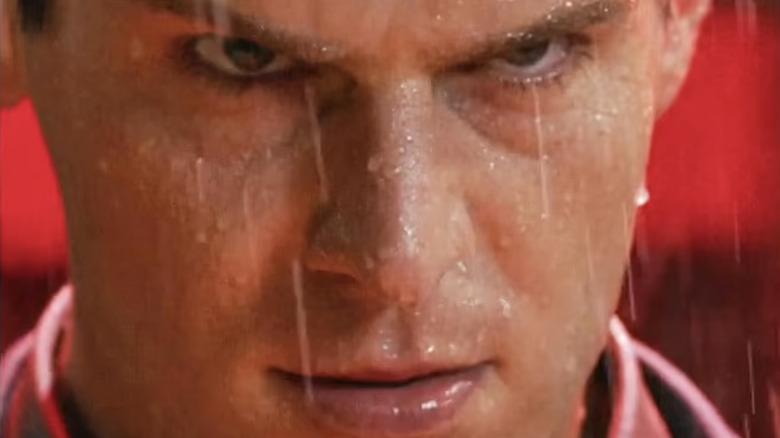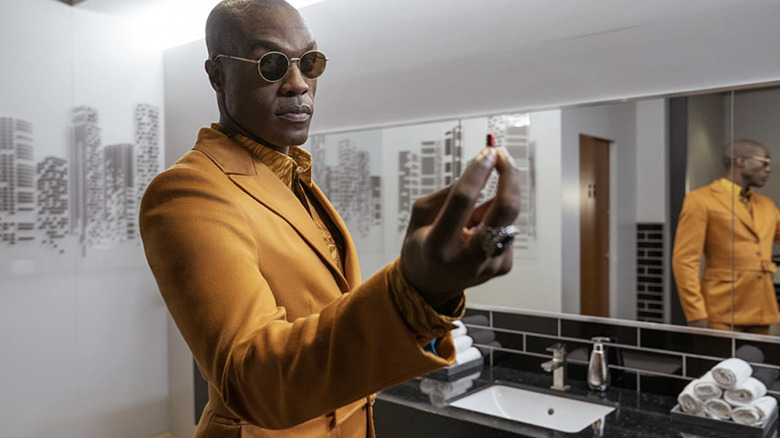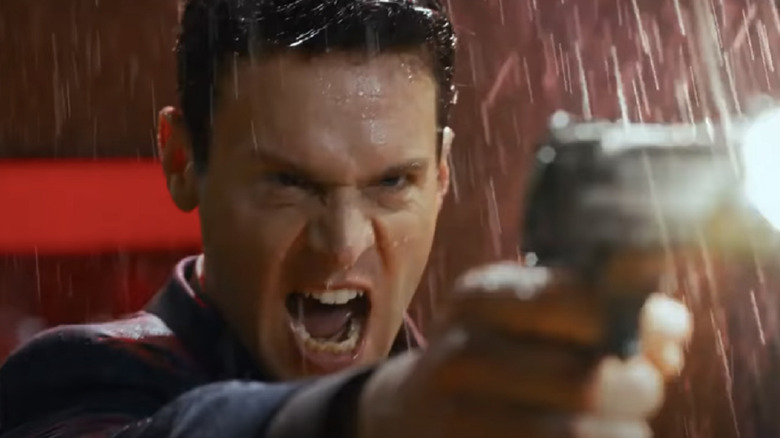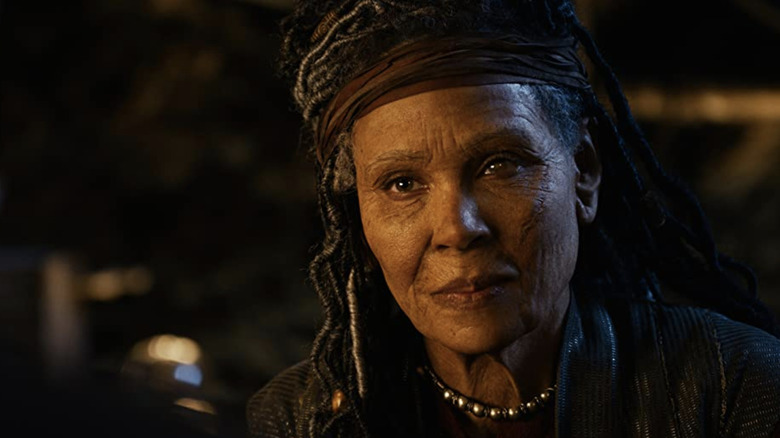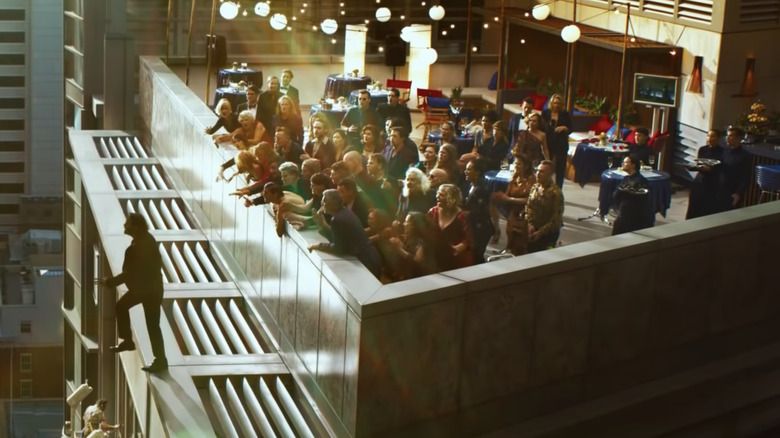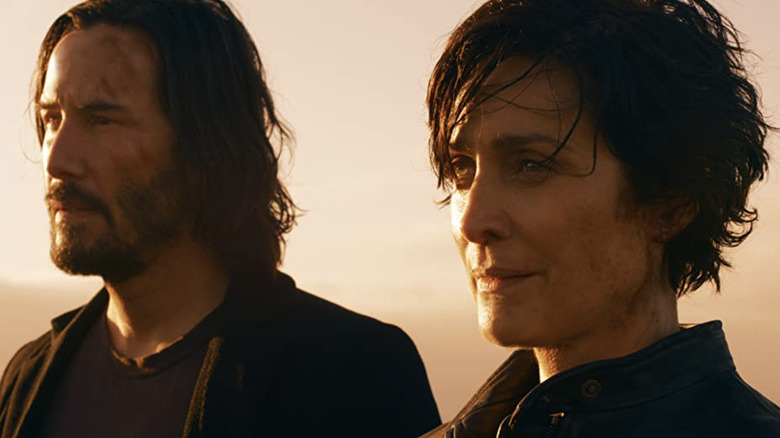Biggest Unanswered Questions In The Matrix Resurrections
To enjoy the "Matrix" franchise has always meant to be comfortable having more questions than answers. Like Neo, you're through the rabbit hole, you've taken the red pill, you're prepared for a discomforting, incongruous reality — and prepared to savor the battle, because you might not always understand the blueprint.
The more things change, the more they stay the same. Nearly 20 years after the original "Matrix" trilogy went out in a hail of slow-mo bullet fire, "The Matrix Resurrections" is bringing the saga back in an eagerly anticipated film. This time around, we once again find Thomas Anderson (Keanu Reeves) trapped in the tedium of office life, convinced the world has more to offer than cubicle incarceration. Once again, Morpheus (albeit one who looks a teensy bit different) comes to open his eyes, with help from some plucky, eccentric friends.
But by the time the final agent has taken a kung fu kick to the face, you'll once again find yourself with plenty of questions. Which is why we've assembled this handy-dandy list of queries, as well as honest attempts at some sort of answer, to help you understand what it all means. After all, to paraphrase the original Morpheus: We can only show you the door. You're the one that has to walk through it.
Why does Morpheus look different?
That's a very good question, and one that for the most part, "Matrix Resurrections" dodges as if it were a slow-mo bullet in mid-air.
Laurence Fishburne's work in the original three films became every bit as iconic as that of Keanu Reeves and Carrie-Anne Moss, a point driven home in "Resurrections" scenes where actors advance the plot of the new film while shots from the original trilogy can be seen projected around them. This isn't a knock on Yahya Abdul-Mateen II, who rocks some amazing outfits and spits out "Matrix" jargon with just as much flair, but longtime "Matrix" fans might be disappointed by the vague inference that over the decades, Morpheus has simply updated himself like a computer operating system.
Of course, in real life there's much more to it than that. "I have not been asked to join them, which is fine," Fishburne told Entertainment Tonight in 2020. "I am hopeful that it will be wonderful and it will satisfy audiences and that people will love it." A few months later, he added that the time off might inspire him to "write another play" and that he's "looking for the blessing in that."
As for Abdul-Mateen, he has seemed to imply that his Morpheus is a different being entirely. "This is definitely a different iteration of the character. I play a character who's definitely aware of the history of the Matrix [and] the history of Morpheus," he told Entertainment Weekly in October of 2021. "This character is on a journey of self-discovery. There's a lot in our story that's about growth, defining your own path. Morpheus isn't exempt from that."
In one key scene, Niobe (Jada Pinkett Smith) shows Neo a statue with the likeness of old-school Morpheus. She explains that after the events of the first trilogy, he was elected the High Chair of the Council, then she seems to imply that the position broke his spirit and eventually led to his ... death? Deletion? In the world of the "Matrix," such things can be hard to nail down.
"Speaking with Lana about that ... it was just creatively where she wanted to go with the production and the story," Keanu Reeves told the UK outlet Unilad when asked about re-entering the Matrix without Fishburne.
"There's an evolution that happened for Lana with the story," added Moss. "And we're here serving that."
While it's unclear how much time Fishburne has recently spent writing, in December 2021 he did appear as a main character on the Peacock series "MacGruber," turning in arguably his funniest work since his Cowboy Curtis days. Singing and joking and somehow keeping a straight face opposite Will Forte, it seems like Fishburne is doing just fine in a world beyond the Matrix.
What's going on with Agent Smith?
This one is similar to the question above, as Hugo Weaving's evil "Matrix" agent was every bit as essential to the original trilogy as Fishburne, similarly is left out of "Resurrections," and has similarly been replaced by a younger actor (in this case, "Mindhunter" star Jonathan Groff) who does an impressive job in the role, even if he is fighting an uphill battle.
In the case of Weaving (who has been known to voice an aversion to blockbuster films), he is on record saying that he was asked to return, but was working on a play called "The Visit" that simply wouldn't allow it. 'I thought [I] could do both and it took eight weeks to work out that the dates would work," he told Time Out London. "I was in touch with Lana Wachowski, but in the end she decided that the dates weren't going to work ... they're pushing on ahead without me."
So instead, we learn early in "Resurrections" that Thomas Anderson is working for a younger, cocky boss (Groff) who is pushing him to revisit the "Matrix" video games that helped build the company. When Anderson inevitably begins to once again see his world bleed together, the boss finds himself in the middle of the ensuing shootout, picking up a gun and revealing himself to be a new and improved Smith.
For Agent Smith, the reinvention makes a bit more sense than Morpheus. Ever since the second "Matrix" film, it has been clear that Smith was changed by those initial encounters with Neo. After an awakening, he has been altering his appearance, increasing his powers and arguably evolving to a more grey area than one of evil. "Resurrections" drives that point home multiple times — as well as the fact that his fate is inextricably linked to that of Neo, and the two of them co-existing as co-workers at the beginning of the film shows a co-dependency, no matter what reality they might inhabit.
Why is Niobe so old?
You can be forgiven if you don't recognize Jada Pinkett Smith, who is under so much old-age makeup in "Resurrections" that audiences might be thankful for a glimpse of her in the "Matrix" sequels to clue them in to who she is.
Although we are originally told that it has been 20 years since the events of the original films, Smith's Niobe explains that's inside the Matrix. For herself and the other humans in rebellion, 60 years have passed. This also explains why a character like Lexy (Erendira Ibarra) is the grandchild of Roland, former captain of the Mjolnir.
Now a general, Niobe has become harder, more bitter, and doesn't suffer fools — which in her mind seems to include Bugs (Jessica Henwick), one of the film's new characters who seems to value passion over patience. After more than 60 years of fighting this seemingly endless battle, who can blame her?
Wait, is that Christina Ricci?
A veteran actor who has spent the last thirty-plus years appearing in everything from blockbusters (like the Wachowski-fueled "Speed Racer") to family films (like the "Addams Family" flicks) to indies like "Buffalo '66" and "Black Snake Moan," Christina Ricci is arguably the second-most famous person in "Matrix Resurrections." So why does the star appear in a role so small and seemingly inconsequential?
Early in "Resurrections," as Thomas Anderson's game company pressures him to once again revisit his "Matrix" world, Lana Wachowski gets in plenty of digs at the sort of pitch meetings that have likely revolved around this franchise in the last 20 years. Arguing that "reboots sell," a dozen or so marketing types pitch ideas around how the series could return and be effectively monetized. One of these is Ricci's character, who drives a sales pitch. Later, she can be seen in a Where's Waldo-like appearance among the many faces during the recurring flashback of Thomas Anderson trying to step off the roof of their building during a company party (look, there she is, wearing the off-the-shoulder dress in the back!).
Perhaps the most likely explanation for Ricci's brief appearance is that it's planting a seed for sequels. The character is named "Gwyn de Vere," which not only feels unnecessarily theatrical for a cameo but also seemingly references Guinevere, the queen of legend and wife of King Arthur.
Another explanation? Well, Ricci did just have a baby, and sometimes real life gets in the way of plans.
A third, and perhaps most likely, explanation is that much of her work was deposited on the cutting room floor. For starters, Ricci's character would have little reason for being featured after Thomas Anderson becomes Neo again, which happens fairly early in the film. In addition, her character is arguably the most meta element of a film overflowing with meta moments. Gwyn de Vere works for Warner Bros. (the studio behind the "Matrix" films), which we are told is the parent company breathing down the necks of Thomas Anderson's gaming company. Perhaps somebody in a real-life WB office took Lana Wachowski's jokes a little too personally?
Whatever the reason, the "Resurrections" audience gets very little Christina Ricci. Here's hoping that if there is a sequel, she gets to expand the role.
Will there be sequels?
If there aren't, it certainly isn't for lack of trying. The ending of "Matrix Resurrections" is filled with all sorts of indications where the franchise could be headed, from the weary survival of the Analyst (Neil Patrick Harris) to the notion that Trinity and Neo will be taking the wheel at rebuilding a kinder, gentler reality with rainbows in the skies.
When the end credits roll, we see the words "The Matrix Resurrects," which could be teasing the name for the next film. Will it explore Trinity's newfound powers, which seem to include flight? Will it further delve into characters like Sati (Priyanka Chopra Jones), who seems to receive very little screentime compared to how significant her character supposedly is? Will it detail all the plot points the Analyst explains about the last 20 years, including his experiments on multiple Neos and Trinitys, or his harnessing of bullet time as a weapon to be used against humanity?
Even if there never is another "Matrix" movie, "Resurrections" could likely stand on its own. The film's story is relatively self-contained, and by the end of the flick there is an uplifting message that seems to indicate a reality as "happy ever after" as any "Matrix" fan could expect.
Ultimately, how the movie is received by audiences and critics will determine whether Neo and Trinity fly again.
